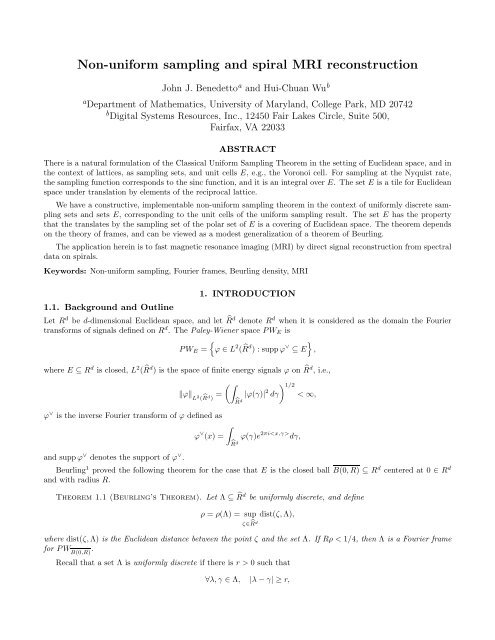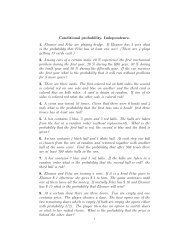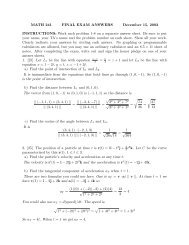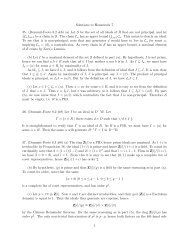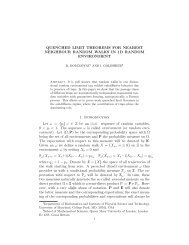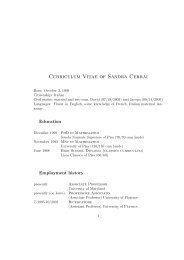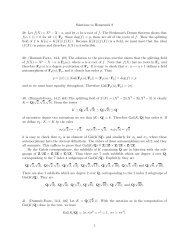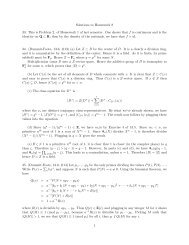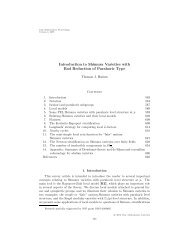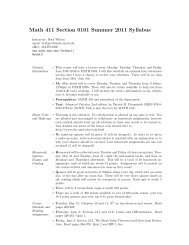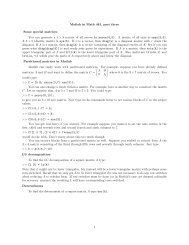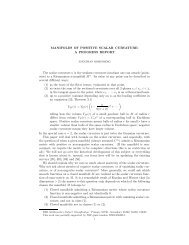Non-uniform sampling and spiral MRI reconstruction - Math ...
Non-uniform sampling and spiral MRI reconstruction - Math ...
Non-uniform sampling and spiral MRI reconstruction - Math ...
You also want an ePaper? Increase the reach of your titles
YUMPU automatically turns print PDFs into web optimized ePapers that Google loves.
where |λ−γ| is the Euclidean distance between λ <strong>and</strong> γ. Fourier frames will be defined in Section 3, but a consequenceof their definition in the assertion of Beurling’s Theorem is that every finite energy signal f defined on E has therepresentationf(x) = ∑ λ∈Λa λ (f)e 2πi (1)in L 2 -norm on E, where ∑ λ∈Λ |a λ(f)| 2 < ∞. Beurling used the term “set of <strong>sampling</strong>” instead of “Fourier frame”.We shall reformulate Beurling’s Theorem in Theorem 7.2, in terms of a covering condition; <strong>and</strong> we shall referto Theorem 7.2 as the Beurling Covering Theorem. Beurling’s Theorem stated above becomes an obvious corollary.Our interest in this topic goes back to a problem about fast magnetic resonance imaging (<strong>MRI</strong>) posed to us by DennisHealy. Besides the present approach to non-<strong>uniform</strong> <strong>sampling</strong> using the power of Beurling’s results, there are otherapproaches 2 . 3In Section 2, we shall discuss the Classical Uniform Sampling Theorem for perspective with the result in Section 7<strong>and</strong> for ultimately comparing lattice <strong>and</strong> tiling ideas with analogous notions from non-<strong>uniform</strong> <strong>sampling</strong>. Fourierframes are introduced Section 3 in order to have a convenient structure in which to develop non-<strong>uniform</strong> <strong>sampling</strong>formulas. Section 4 is devoted to a discussion of density criteria in the setting of completeness results, <strong>and</strong> suchcriteria are essential for underst<strong>and</strong>ing effective signal <strong>reconstruction</strong> from non-<strong>uniform</strong>ly spaced sampled values. Westate the fundamental characterization of Fourier frames in terms of density in Section 5.The notion of balayage is defined in Section 6; <strong>and</strong> Beurling’s theorem (1959), 4 describing the fundamentalrelationship between balayage <strong>and</strong> Fourier frames, is stated. This relationship is an essential component of theBeurling Covering Theorem in Section 7. We also take the opportunity to make some preliminary comments aboutrelated on-going work relating dimensionality, tilings, lattices, <strong>and</strong> coverings.In Section 8 we shall use the Beurling Covering Theorem to solve a mathematical version of the aforementionedproblem concerning fast <strong>MRI</strong>. 5 Basically, spectral (Fourier transform) data of an unknown signal f is given on adiscrete subset of finitely many interleaving <strong>spiral</strong>s contained in ̂R 2 ; <strong>and</strong> the problem is to extract the original signalf ∈ L 2 (R 2 ) from this data whenever possible. Our solution is contained in Examples 2 <strong>and</strong> 3. In these examples, weshall provide a proof <strong>and</strong> algorithm for characterizing <strong>and</strong> constructing a <strong>uniform</strong>ly discrete spectral subset Λ ⊆ ̂R 2on given interleaving <strong>spiral</strong>s with the property that Λ is a Fourier frame in the sense of (1).Complete proofs of the aforementioned results, along with an analysis <strong>and</strong> history of the various relevant conceptsof density, will appear in a forthcoming research tutorial, 6 which also contains a complete bibliography.1.2. NotationWe shall use st<strong>and</strong>ard notation from harmonic analysis 7 . 8Further, M( ̂R d ) is the convolution algebra of bounded Radon measures on ̂R d ; <strong>and</strong>, if Λ ⊆ ̂R d is closed, thenM(Λ) denotes the closed subspace of M( ̂R) d consisting of those elements supported by Λ. Integration over Euclideanspace will be denoted by “ ∫ ”; <strong>and</strong> the Fourier transform ̂f of f defined on R d is formally given by∫ϕ(γ) = ̂f(γ) = f(x)e −2πi dx,where γ ∈ ̂R d . A(R d ) is the space of absolutely convergent inverse Fourier transforms on R d ,<strong>and</strong>A ′ (R d ), its dualspace when A(R d ) is normed by‖ϕ ∨ ‖ A(R d ) = ‖ϕ‖ L 1 (R d ),is the space of pseudo-measures on R d . B b (E) is the space of bounded continuous functions ϕ on ̂R d for whichsupp ϕ ∨ ⊆ E, where E is closed <strong>and</strong> ϕ ∨ is the distributional inverse Fourier transform of ϕ. Clearly, B b (E) ∧ ⊆ A ′ (R d ).Finally, we write e λ (x) =e 2πi for x ∈ R d <strong>and</strong> γ ∈ ̂R d .
Definition 3.3 (Fourier Frames).a. Let R>0, <strong>and</strong> assume that the sequence {e λ : λ ∈ Λ} is a frame for H = L 2 [−R, R]. This is clearly equivalentto the assertion that there exist A, B > 0 such that∀F ∈ PW R ,A‖F ‖ 2 L 2 (̂R) ≤ ∑ λ∈Λ|F (λ)| 2 ≤ B‖F ‖ 2 L 2 (̂R) . (6)As such we say that {e λ : λ ∈ Λ} is a Fourier frame for L 2 [−R, R], <strong>and</strong> by (5) we have∀f ∈ L 2 [−R, R], f = ∑ λ∈Λa λ (f)e λ in L 2 [−R, R]. (7)(7) is a non-harmonic Fourier series, see Chapter VII of Paley <strong>and</strong> Wiener. 10b. The frame radius R f (Λ) of Λ isR f (Λ) = sup{R ≥ 0:{e λ } is a Fourier frame for L 2 [−R, R]}.Example 1. Let us switch the notation R d <strong>and</strong> ̂R d in Theorem 2.3. We let Λ ⊆ ̂R d be a lattice, <strong>and</strong> we letE ⊆ R d be a unit cell of the reciprocal lattice. Then, if F ∈ L 2 ( ̂R d ) is a continuous function with the property thatf = F ∨ =0a.e. off of E, we have the <strong>sampling</strong> formulain L 2 (R). More generally, if Λ ⊆ ̂R d is a Fourier frame for PW E , then( )f(x) = 1 ∑F (λ)e 2πi 1 E (x) (8)|E|λ∈Λ∀f ∈ L 2 (E),f(x) = ∑ λ∈Λc λ e 2πiin L 2 (E), which can be compared with (8).4. DENSITY CRITERIA FOR COMPLETENESSIn order to gain insight into the structure of sets Λ ⊆ ̂R d for which {e λ : λ ∈ Λ} is a Fourier frame for PW E forsome E ⊆ R d , it is reasonable to consider first criteria for which {e λ : λ ∈ Λ} is complete in the case Λ ⊆ ̂R. Tobeprecise we let Λ = {λ k : k ∈ Z, λ −1 < 0 ≤ λ 0 , <strong>and</strong> lim k→±∞ λ k = ±∞} ⊆ ̂R be a strictly increasing sequence, whichis <strong>uniform</strong>ly discrete or separated in the sense that∃r >0 such that ∀k ∈ Z, λ k+1 − λ k ≥ r.Further, for each R>0, we letX R = span {e λ : λ ∈ Λ}denote the closed linear span of {e λ : λ ∈ Λ} in L 2 [−R, R]. Paley <strong>and</strong> Wiener 10 (Chapter VI) refer to X R as the“closure” of the set {e λ : λ ∈ Λ} of complex exponential functions. If X R = L 2 [−R, R], then {e λ : λ ∈ Λ} is completein L 2 [−R, R].Definition 4.1 (The Closure of Sets of Complex Exponential Functions).a. The radius of completeness R c (Λ) of Λ isR c (Λ) = sup{R ≥ 0:X R = L 2 [−R, R]}.R c (Λ) is well-defined since it is clear that if R 1
R>R c (Λ). R c (Λ) is equal to the radii of completeness for the L p -spaces L p [−R, R], 1 ≤ p0 let n(γ) be the cardinalityof {λ k : k ≥ 1 <strong>and</strong> λ k ≤ γ}. Ifn(γ)lim > 2R, (9)γ→∞ γthen X R = L 2 [−R, R].Remark 2 (Completeness <strong>and</strong> Density).a. The “lim” on the left side of (9) is a density condition, <strong>and</strong> such conditions are essential hypotheses, notonly for completeness theorems such as Theorem 4.2 <strong>and</strong> Equation (15) below, but also for non-<strong>uniform</strong> <strong>sampling</strong>formulas.In engineering terms <strong>and</strong> in the context of non-<strong>uniform</strong> <strong>sampling</strong>, we can expect completeness if the number ofsamples per unit time exceeds on average twice the largest frequency in the given signal, i.e., if the average <strong>sampling</strong>rate exceeds the Nyquist rate. This <strong>sampling</strong> criteria is a density condition, <strong>and</strong> accurately quantifying the correctdensity to obtain completeness is difficult.Further, there are genuine engineering applications of some of these completeness theorems in uniquely determiningsignals from their non-<strong>uniform</strong>ly spaced samples, e.g., Beutler’s work (1966) using results of Levinson.b. Paley <strong>and</strong> Wiener’s book (1934) 10 is the progenitor <strong>and</strong> driving force for an extensive <strong>and</strong> deep theory relatingrefinements of Theorem 4.2 with various notions of density, see Definition 4.3. Some of the many notable works sincethen are due to Levinson (1940), Duffin-Eachus (1942) <strong>and</strong> Duffin-Schaeffer 9 (1952), Kahane (1962), Beurling <strong>and</strong>L<strong>and</strong>au, e.g., L<strong>and</strong>au 11 (1967), <strong>and</strong> Beurling <strong>and</strong> Malliavin (1962 <strong>and</strong> 1967).There are also world class expositions due to Koosis (1970 <strong>and</strong> 1996) <strong>and</strong> Redheffer (1977) reflecting the authors’profound underst<strong>and</strong>ing of the problems <strong>and</strong> their own seminal contributions from the 1960s, cf., Boas’ book (1954)<strong>and</strong> a more recent <strong>and</strong> justly influential book due to Young (1980).This material is exp<strong>and</strong>ed as background in a forthcoming tutorial on multidimensional non-<strong>uniform</strong> <strong>sampling</strong>. 6Definition 4.3 (Density Criteria).Let Λ = {λ k : k ∈ Z, λ −1 < 0 ≤ λ 0 , <strong>and</strong> lim k→±∞ λ k = ±∞} ⊆ ̂R be a strictly increasing <strong>uniform</strong>ly discretesequence, <strong>and</strong> define the functionn Λ = ∑ k1 [λk ,λ k+1 )whose distributional derivative is n ′ Λ = ∑ λ∈Λ δ λ. Clearly, if n :(0, ∞) →{0, 1,...} is defined by n(γ) =card{λ k :|λ k |≤γ}, where “card” is cardinality, then n(γ) =n Λ (γ) − n Λ (−γ).a. A reasonable definition of the density of Λ isn(γ)limγ→∞ 2γwhen this limit exists. As such, <strong>and</strong> since n Λ (γ k )=k, we shall define the natural density of Λ asD n (Λ) =lim|k|→∞kλ k(10)when the limit in (10) exists. Otherwise, we consider the upper, resp., lower, natural densitiesD + n (Λ) =b. Λ has <strong>uniform</strong> density D u (Λ) > 0iflim|k|→∞kλ k, resp., D − n (Λ) = lim|k|→∞kλ k.
Definition 6.2. Let E ⊆ R d be a symmetric body with polar set E ∗ . An entire function ϕ on C d is of exponentialtype E ∗ if∀ɛ >0, ∃A ɛ > 0such that∀z ∈ C d , |ϕ(z)| ≤A ɛ e 2π(1+ɛ)‖z‖E .The classical Plancherel-Pólya Theorem, originally proved on R, has the following formulation on R d , see pages108–114 of Stein <strong>and</strong> Weiss. 8Theorem 6.3. (Plancherel-Pólya Theorem) Let E be a symmetric body <strong>and</strong> let p>1. Ifϕ is an entire function ofexponential type E ∗ , then(∫) 1/p∀ξ ∈ ̂R d , |ϕ(γ + iξ)| p dγ ≤ e 2π‖ξ‖ E ∗ ‖ϕ‖Lp (̂R d ).̂R dThe Plancherel-Pólya Theorem can be used to prove the following Paley-Wiener Theorem. Generally, we shalluse the elementary sufficient conditions of the Paley-Wiener Theorem in order to obtain a function of exponentialtype; <strong>and</strong> then we use this property of a given function in order to invoke Plancherel-Pólya.Theorem 6.4. (Paley-Wiener Theorem) Let E ⊆ R d be a symmetric body, <strong>and</strong> let ϕ ∈ L 2 ( ̂R d ).Thensupp ϕ ∨ ⊆ Eif <strong>and</strong> only if ϕ is the restriction to ̂R d of an entire function of exponential type E ∗ .Definition 6.5. a. Let E ⊆ R d , <strong>and</strong> let μ, ν ∈ M( ̂R d ). The notation μ ∼ E ν denotes the property that μ ∨ = ν ∨on E.b. Let E ⊆ R d ,<strong>and</strong>letΛ⊆ ̂R d be a closed set. Balayage is possible for (E,Λ) if∀μ ∈ M( ̂R d ), ∃ν ∈ M(Λ) such that μ ∨ = ν ∨ on E,i.e., for each μ ∈ M( ̂R d ), there is a ν ∈ M(Λ) such that μ ∼ E ν.The following is a consequence of the Open Mapping Theorem.Let E ⊆ R d ,<strong>and</strong>letΛ⊆ ̂R d be a closed set. Assume balayage is possible for (E,Λ). There is K>0 such that∀μ ∈ M( ̂R d ),inf ‖ν‖ M(Λ) ≤ K‖μ‖ . (17)ν∈M(Λ),μ∼ M(̂R Eν d )The infimum of those K for which (17) holds is designated K(E,Λ).Beurling considered the following two properties on a closed set E ⊆ R d .(α) For each x 0 ∈ E <strong>and</strong> each ɛ>0, there is μ ɛ ∈ M(B(x 0 ,ɛ) ∩ E) such that lim |γ|→∞ ̂μ ɛ (γ) =0;(β) E is a set of spectral synthesis, i.e., T (f) = 0 for all f ∈ A(R d ) <strong>and</strong> all T ∈ A ′ (R d ) with the properties thatf =0onE <strong>and</strong> supp T ∈ A ′ (R d ).Clearly, if int E ≠ 0, then condition (α) is satisfied. There are other equivalent formulations of condition (β).For example, condition (β) is satisfied if <strong>and</strong> only if ∫ ϕ(γ) dμ(γ) = 0 for all ϕ ∈B b (E) <strong>and</strong> all μ ∈ M( ̂R d ) with theproperty that μ ∨ =0onE. We shall use the fact that closed, convex sets E ⊆ R d are sets of spectral synthesis.The following result was proved by Beurling. 4Lemma 6.6. Let E ⊆ R d be a compact set satisfying properties (α) <strong>and</strong> (β), <strong>and</strong>letE ɛ = {x : dist(x, E) ≤ ɛ}. IfK(E,Λ) < ∞, then there exists ɛ 0 such that∀ 0
<strong>and</strong> consequently the ordinary distance, from any point on the <strong>spiral</strong> A k to Λ k is less than δ. Finally, we setΛ R = ∪ M−1k=0 Λ k. Thus, by the triangle inequality,∀ξ ∈ ̂R 2 , dist(ξ,Λ R ) ≤ dist(ξ,B) + dist(B,Λ R ) ≤ c2M + δ = ρ.Hence, Rρ < 1/4 by our choice of M <strong>and</strong> δ; <strong>and</strong> so we can invoke Beurling’s Covering Theorem, Theorem 7.2, or theoriginal formulation state in the Introduction, to conclude that Λ R is a Fourier frame for PW B(0,R).Note that since we are reconstructing signals on a space domain having area about R 2 , we require essentially Rinterleaving <strong>spiral</strong>s. On the other h<strong>and</strong>, if we are allowed to choose the <strong>spiral</strong>(s) after we are given PW B(0,R), thenwe can choose Λ R contained in a single <strong>spiral</strong> A c for c>0 small enough.REFERENCES1. A. Beurling, “Local harmonic analysis with some applications to differential operators,” in Proc. Annual ScienceConference, pp. 109–125, Belfer Graduate School of Science, 1966.2. J. J. Benedetto, “Irregular <strong>sampling</strong> <strong>and</strong> frames,” in Wavelets–A Tutorial in Theory <strong>and</strong> Applications, C.K.Chui, ed., pp. 445–507, Academic Press, Boston, 1992.3. K. Grochenig, “<strong>Non</strong>-<strong>uniform</strong> <strong>sampling</strong> in higher dimensions: from trigonometric polynomials to b<strong>and</strong>limitedfunctions,” in Modern Sampling Theory: <strong>Math</strong>ematics <strong>and</strong> Applications, J. Benedetto <strong>and</strong> P. Ferreira, eds.,p. Chapter 7, Birkhauser, Boston, 2000.4. A. Beurling, “On balayage of measures in Fourier transforms (Seminar, Inst. for Advanced Studies, 1959–60,unpublished),” in Collected Works of Arne Beurling, L. Carleson, P. Malliavin, J. Neuberger, <strong>and</strong> J. Wermer,eds., Birkhauser, Boston, 1989.5. M. Bourgeois, F. T. A. W. Wajer, D. van Ormondt, <strong>and</strong> D. Graveron-Demilly, “Reconstruction of <strong>MRI</strong> imagesfrom non-<strong>uniform</strong> <strong>sampling</strong>, application to intrascan motion correction in functional <strong>MRI</strong>,” in Modern SamplingTheory: <strong>Math</strong>ematics <strong>and</strong> Applications, J. Benedetto <strong>and</strong> P. Ferreira, eds., p. Chapter 16, Birkhauser, Boston,2000.6. J. Benedetto <strong>and</strong> H.-C. Wu, “The Beurling-L<strong>and</strong>au theory of Fourier frames <strong>and</strong> applications,” J. FourierAnalysis <strong>and</strong> Applications 6, 2000.7. J. J. Benedetto, Harmonic Analysis <strong>and</strong> Applications, CRC Press, Inc., Boca Raton, FL, 1997.8. E. Stein <strong>and</strong> G. Weiss, An Introduction to Fourier Analysis on Euclidean Space, Princeton University Press,Princeton, NJ, 1971.9. R. J. Duffin <strong>and</strong> A. C. Schaeffer, “A class of nonharmonic Fourier series,” Trans. Amer. <strong>Math</strong>. Soc. 72, pp. 341–366, 1952.10. R. Paley <strong>and</strong> N. Wiener, Fourier transforms in the complex domain, Amer. <strong>Math</strong>. Soc. Colloquium Publ. 19,New York, 1934.11. H. J. L<strong>and</strong>au, “Necessary density conditions for <strong>sampling</strong> <strong>and</strong> interpolation of certain entire function,” Acta<strong>Math</strong>. 117, pp. 37–52, 1967.12. S. Jaffard, “A density criterion for frames of complex exponentials,” Michigan <strong>Math</strong>. J. 38, pp. 339–348, 1991.


